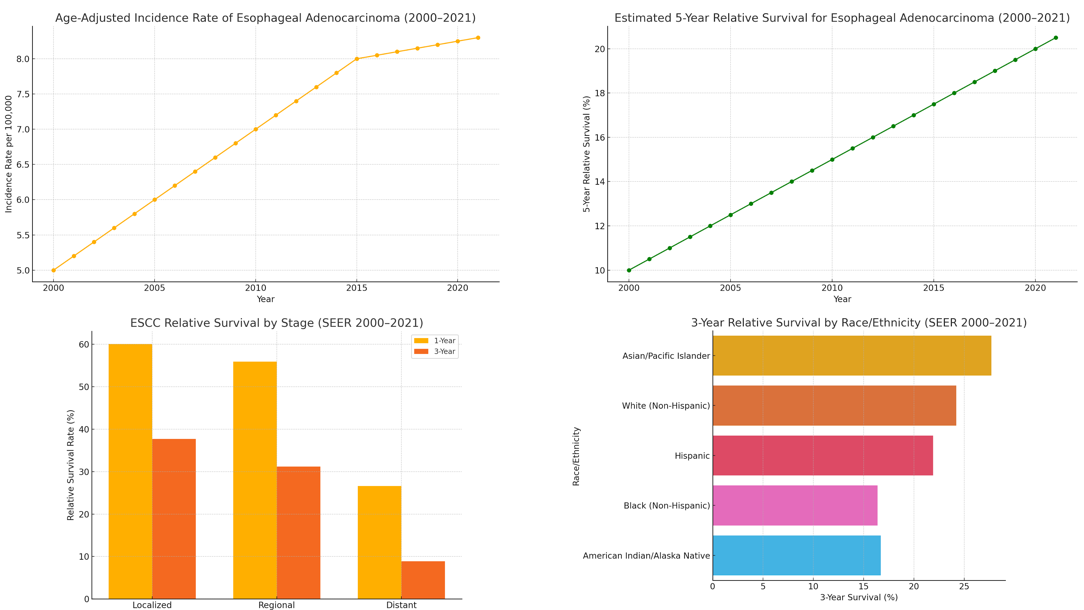Monday Poster Session
Category: Esophagus
P2784 - Trends in Incidence, Survival, and Emerging Therapies in Esophageal Cancer: A SEER-Based Analysis From 2000 to 2021
Monday, October 27, 2025
10:30 AM - 4:00 PM PDT
Location: Exhibit Hall

Aura Calderon, MD (she/her/hers)
University of Texas Rio Grande Valley
McAllen, Texas
Presenting Author(s)
Aura Calderon, MD1, Ivan Mogollon, MD2, Everardo Cobos, MD2
1University of Texas Rio Grande Valley, McAllen, TX; 2University of Texas Rio Grande Valley, Edinburg, TX
Introduction: Esophageal cancer remains a major global health concern, ranking among the top ten most common cancers and sixth in cancer-related mortality. Esophageal squamous cell carcinoma (ESCC) predominates in developing countries, while esophageal adenocarcinoma (EAC) has risen in developed regions due to obesity, GERD, and Barrett’s esophagus. Despite advances in therapy, most cases are diagnosed at advanced stages, resulting in poor overall survival. Understanding the evolving epidemiology and disparities in outcomes is essential to improving early detection and treatment. The aim of this article is to evaluate incidence trends, survival outcomes, and demographic disparities in ESCC and EAC using SEER data from 2000 to 2021.
Methods: A retrospective population-based analysis was conducted using SEER data from 2000–2021. Cases of esophageal cancer were stratified by histologic subtype, stage, sex, age, and race/ethnicity. Incidence trends and 1- and 3-year relative survival rates were calculated and compared across subgroups.
Results: EAC incidence rose until the mid-2010s, particularly among non-Hispanic White males aged 50–75. ESCC incidence declined over the same period. In ESCC, 1-year survival was 60.1% (localized), 55.9% (regional), and 26.6% (distant), decreasing at 3 years to 37.7%, 31.2%, and 8.9%, respectively. For EAC, 3-year survival was higher in females (26.1%) than males (20.2%). Racial disparities were notable: Asian/Pacific Islanders (27.7%), Whites (24.2%), Hispanics (21.9%), American Indians/Alaska Natives (16.7%), and Blacks (16.4%). Survival also declined with age: < 50 years (24.5%), 50–64 (22.9%), and ≥65 (21.7%). (Figure 1)
Discussion: Although ESCC and EAC share a poor prognosis and late-stage detection, they differ in epidemiology, demographic distribution, and survival. EAC is increasing in developed countries and has lower long-term survival. ESCC remains lethal in resource-limited settings. Disparities in outcomes highlight inequities in healthcare access and diagnostic timing. While novel therapies, including immunotherapy and targeted agents, offer hope, their reach remains inconsistent. Advancing early diagnosis, equitable care, and biomarker-driven treatment is essential to improving prognosis and reducing the global burden of esophageal cancer.

Figure: Figure 1. Summary of esophageal cancer trends, including age-adjusted incidence and 5-year relative survival for adenocarcinoma , stage-specific survival for squamous cell carcinoma and 3-year relative survival by race/ethnicity.
Disclosures:
Aura Calderon indicated no relevant financial relationships.
Ivan Mogollon indicated no relevant financial relationships.
Everardo Cobos indicated no relevant financial relationships.
Aura Calderon, MD1, Ivan Mogollon, MD2, Everardo Cobos, MD2. P2784 - Trends in Incidence, Survival, and Emerging Therapies in Esophageal Cancer: A SEER-Based Analysis From 2000 to 2021, ACG 2025 Annual Scientific Meeting Abstracts. Phoenix, AZ: American College of Gastroenterology.
1University of Texas Rio Grande Valley, McAllen, TX; 2University of Texas Rio Grande Valley, Edinburg, TX
Introduction: Esophageal cancer remains a major global health concern, ranking among the top ten most common cancers and sixth in cancer-related mortality. Esophageal squamous cell carcinoma (ESCC) predominates in developing countries, while esophageal adenocarcinoma (EAC) has risen in developed regions due to obesity, GERD, and Barrett’s esophagus. Despite advances in therapy, most cases are diagnosed at advanced stages, resulting in poor overall survival. Understanding the evolving epidemiology and disparities in outcomes is essential to improving early detection and treatment. The aim of this article is to evaluate incidence trends, survival outcomes, and demographic disparities in ESCC and EAC using SEER data from 2000 to 2021.
Methods: A retrospective population-based analysis was conducted using SEER data from 2000–2021. Cases of esophageal cancer were stratified by histologic subtype, stage, sex, age, and race/ethnicity. Incidence trends and 1- and 3-year relative survival rates were calculated and compared across subgroups.
Results: EAC incidence rose until the mid-2010s, particularly among non-Hispanic White males aged 50–75. ESCC incidence declined over the same period. In ESCC, 1-year survival was 60.1% (localized), 55.9% (regional), and 26.6% (distant), decreasing at 3 years to 37.7%, 31.2%, and 8.9%, respectively. For EAC, 3-year survival was higher in females (26.1%) than males (20.2%). Racial disparities were notable: Asian/Pacific Islanders (27.7%), Whites (24.2%), Hispanics (21.9%), American Indians/Alaska Natives (16.7%), and Blacks (16.4%). Survival also declined with age: < 50 years (24.5%), 50–64 (22.9%), and ≥65 (21.7%). (Figure 1)
Discussion: Although ESCC and EAC share a poor prognosis and late-stage detection, they differ in epidemiology, demographic distribution, and survival. EAC is increasing in developed countries and has lower long-term survival. ESCC remains lethal in resource-limited settings. Disparities in outcomes highlight inequities in healthcare access and diagnostic timing. While novel therapies, including immunotherapy and targeted agents, offer hope, their reach remains inconsistent. Advancing early diagnosis, equitable care, and biomarker-driven treatment is essential to improving prognosis and reducing the global burden of esophageal cancer.

Figure: Figure 1. Summary of esophageal cancer trends, including age-adjusted incidence and 5-year relative survival for adenocarcinoma , stage-specific survival for squamous cell carcinoma and 3-year relative survival by race/ethnicity.
Disclosures:
Aura Calderon indicated no relevant financial relationships.
Ivan Mogollon indicated no relevant financial relationships.
Everardo Cobos indicated no relevant financial relationships.
Aura Calderon, MD1, Ivan Mogollon, MD2, Everardo Cobos, MD2. P2784 - Trends in Incidence, Survival, and Emerging Therapies in Esophageal Cancer: A SEER-Based Analysis From 2000 to 2021, ACG 2025 Annual Scientific Meeting Abstracts. Phoenix, AZ: American College of Gastroenterology.
